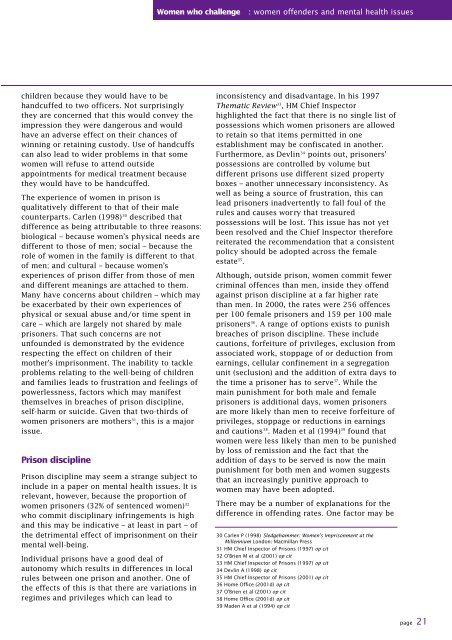Women who challenge - Nacro
Women who challenge - Nacro
Women who challenge - Nacro
- No tags were found...
You also want an ePaper? Increase the reach of your titles
YUMPU automatically turns print PDFs into web optimized ePapers that Google loves.
<strong>Women</strong> <strong>who</strong> <strong>challenge</strong>: women offenders and mental health issueschildren because they would have to behandcuffed to two officers. Not surprisinglythey are concerned that this would convey theimpression they were dangerous and wouldhave an adverse effect on their chances ofwinning or retaining custody. Use of handcuffscan also lead to wider problems in that somewomen will refuse to attend outsideappointments for medical treatment becausethey would have to be handcuffed.The experience of women in prison isqualitatively different to that of their malecounterparts. Carlen (1998) 30 described thatdifference as being attributable to three reasons:biological – because women’s physical needs aredifferent to those of men; social – because therole of women in the family is different to thatof men; and cultural – because women’sexperiences of prison differ from those of menand different meanings are attached to them.Many have concerns about children – which maybe exacerbated by their own experiences ofphysical or sexual abuse and/or time spent incare – which are largely not shared by maleprisoners. That such concerns are notunfounded is demonstrated by the evidencerespecting the effect on children of theirmother’s imprisonment. The inability to tackleproblems relating to the well-being of childrenand families leads to frustration and feelings ofpowerlessness, factors which may manifestthemselves in breaches of prison discipline,self-harm or suicide. Given that two-thirds ofwomen prisoners are mothers 31 , this is a majorissue.Prison disciplinePrison discipline may seem a strange subject toinclude in a paper on mental health issues. It isrelevant, however, because the proportion ofwomen prisoners (32% of sentenced women) 32<strong>who</strong> commit disciplinary infringements is highand this may be indicative – at least in part – ofthe detrimental effect of imprisonment on theirmental well-being.Individual prisons have a good deal ofautonomy which results in differences in localrules between one prison and another. One ofthe effects of this is that there are variations inregimes and privileges which can lead toinconsistency and disadvantage. In his 1997Thematic Review 33 , HM Chief Inspectorhighlighted the fact that there is no single list ofpossessions which women prisoners are allowedto retain so that items permitted in oneestablishment may be confiscated in another.Furthermore, as Devlin 34 points out, prisoners’possessions are controlled by volume butdifferent prisons use different sized propertyboxes – another unnecessary inconsistency. Aswell as being a source of frustration, this canlead prisoners inadvertently to fall foul of therules and causes worry that treasuredpossessions will be lost. This issue has not yetbeen resolved and the Chief Inspector thereforereiterated the recommendation that a consistentpolicy should be adopted across the femaleestate 35 .Although, outside prison, women commit fewercriminal offences than men, inside they offendagainst prison discipline at a far higher ratethan men. In 2000, the rates were 256 offencesper 100 female prisoners and 159 per 100 maleprisoners 36 . A range of options exists to punishbreaches of prison discipline. These includecautions, forfeiture of privileges, exclusion fromassociated work, stoppage of or deduction fromearnings, cellular confinement in a segregationunit (seclusion) and the addition of extra days tothe time a prisoner has to serve 37 . While themain punishment for both male and femaleprisoners is additional days, women prisonersare more likely than men to receive forfeiture ofprivileges, stoppage or reductions in earningsand cautions 38 . Maden et al (1994) 39 found thatwomen were less likely than men to be punishedby loss of remission and the fact that theaddition of days to be served is now the mainpunishment for both men and women suggeststhat an increasingly punitive approach towomen may have been adopted.There may be a number of explanations for thedifference in offending rates. One factor may be30 Carlen P (1998) Sledgehammer: <strong>Women</strong>’s Imprisonment at theMillennium London: Macmillan Press31 HM Chief Inspector of Prisons (1997) op cit32 O’Brien M et al (2001) op cit33 HM Chief Inspector of Prisons (1997) op cit34 Devlin A (1998) op cit35 HM Chief Inspector of Prisons (2001) op cit36 Home Office (2001d) op cit37 O’Brien et al (2001) op cit38 Home Office (2001d) op cit39 Maden A et al (1994) op citpage 21
















